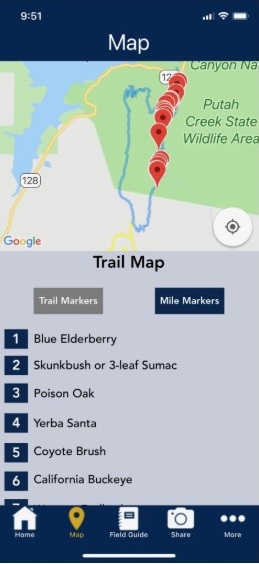
Going for a hike in Stebbins Cold Canyon? Thanks to UC Davis computer science students, there’s an app for that!
By Lisa Howard, originally posted by the UC Davis Office of Research.
A group of UC Davis students has created an iPhone app that allows visitors to the Stebbins Cold Canyon trail to view wildlife guides, maps and safety information to enhance their enjoyment of the trail. This is one of the first apps in the country for a natural reserve or field station and it is available for free in the Apple App Store.
The creation of the app was part of a project-based senior class, ECS 193AB, taught by Xin Liu, a professor in the UC Davis Department of Computer Science. “This project provided an excellent educational opportunity for our Computer Science senior design students to work on real-life design challenges with real clients,” said Liu.
The 600-acre reserve is used by UC Davis researchers and classes for a variety of studies, including wildfire ecology, climate change, habitat restoration and stream invertebrates. In addition, Stebbins Cold Canyon also has a popular public hiking trail, attracting about 50,000 visitors every year.
The students — Kavitha Dhanukodi, Henry Jue, Josephine Situ and Adam Strauss — were aware that all of these visitors need to interact in harmony with the research, and in a way that maximizes safety and minimizes risk. Before starting work on the app, they first interviewed Natural Reserve System staff at UC Davis to determine what was most needed to help manage the reserve.
“We wanted the app to not only educate users about the many interesting plants and animals they could see along the trail, but to also help the public understand where they are on the trail and what safety measures they could take to ensure a safe hike,” said Sarah Oktay, Stebbins Cold Canyon Reserve Director. Oktay oversaw the student project along with Paul Havemann, the steward for Stebbins Cold Canyon.
The popular reserve is administered by UC Davis and the Muir Institute. It is one of 41 that are part of the University of California Natural Reserve System, the largest and most diverse network of university field stations in the world. It features a strenuous five-mile Blue Ridge Loop trail with spectacular views of Lake Berryessa and the Berryessa Snow Mountain National Monument.

The 2015 Wragg Fire burned the vegetation that had provided shade along the trail so visitors are now exposed to very hot and dry conditions that can be dangerous if visitors are unprepared. The recommendation is to bring one gallon of water per person and to only hike during the cooler parts of the day, usually early morning in summer.
Each year at the peak of summer a few trail users have to be evacuated by helicopter from the top of the ridge due to symptoms of heat exhaustion and heat stroke. That’s one of the reasons why the app the students created is packed with safety advice and trail rules so visitors can avoid everything from heat exhaustion to poison oak.
One challenge the team faced was that not all the areas of the reserve have internet access.
“The students had to develop an app that can work with GPS when the internet isn’t available,” said Liu.
By relying on Global Positioning System (GPS) technology for the app—which relies on satellites, not a web connection — the app can track location and help visitors figure out where they are on the trail.
The app also includes an emergency feature that dials the Solano County Emergency Service Office if it is used where cell phone coverage is available.
Other interactive features in the app include a “Report an Incident” form for reporting fallen trees, high water, graffiti or other trail conditions, as well as an upload feature for submitting trail pictures.
“I am very happy the app is available for visitors to Stebbins Cold Canyon,” said Liu. “The project also has the potential to be a model for similar natural reserves and field stations. As a person who enjoys nature and hiking, I would love to see that happen in the future.”
To download the free app, search for “Stebbins Cold Canyon” in the Apple App Store.




